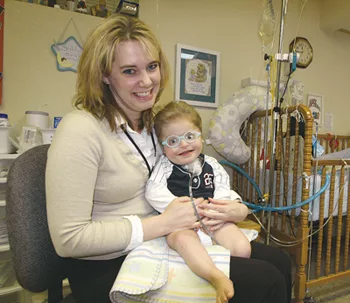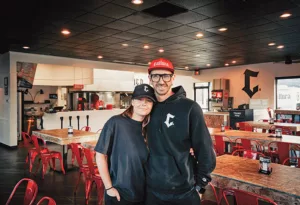
Home » Helping children come home
Helping children come home
Norco employee installs equipment for children dependent on ventilators

May 6, 2010
Respiratory therapist Rebecca Strebeck has developed a specialty here of helping children suffering from respiratory failure to come home from the hospital.
Often, she turns their bedrooms into residential versions of intensive-care units.
"Having a baby on a ventilator is not the end of the world," says Strebeck, who works in the medical supply division at Boise-based Norco Inc.'s Spokane Valley outlet.
Pediatric ventilators pump air into and out of tiny patients' lungs through tubes connected to tracheostomy fittings surgically implanted in the front of patients' necks, providing a direct path to the patient's airway.
They often are needed for infants and children who suffer from ailments such as underdeveloped or improperly functioning respiratory systems.
Being tethered to a ventilator doesn't have to stop children from enjoying all normal activities, she says, adding that children often can reduce their dependence on the machines as they gain strength.
For many families, providing intensive care at home is their only option for continuing insurance coverage once their hospital coverage is tapped out.
"It's a lot less expensive to be at home than in a hospital ICU," Strebeck says. "If parents can get the child home, they can get further help for acute care, which insurance companies pay for from a different pool of money."
It costs about $6,000 a month for equipment rentals, supplies, and 16-hour-a-day, in-home nursing care for ventilator-dependent babies.
Strebeck came to Norco after having been a respiratory therapist at Providence Sacred Heart Medical Center & Children's Hospital for nine years, with most of her experience in the neonatal and pediatric ICUs, and the pediatric emergency room.
After Norco hired her as a respiratory therapist, she received several inquiries from the hospital about whether at-home medical services were available for pediatric patients with respiratory failure.
"I realized no one was addressing kids, and I wanted to take us in that direction," she says."Hospitals are in a difficult position. Hospitals charge for an ICU room on a 12-hour basis. A lot of times insurance cuts off after $1 million, and hospitals aren't reimbursed after that."
Strebeck had to research how to set up medical equipment needed for an in-home ICU, and she had to train parents and home nurses how to operate the equipment and provide special care the children would need.
Her first ventilator-dependent patient, who had been in the hospital for almost a year since birth, had nowhere else to go once the insurance ran out.
"We got her home a week before her birthday," Strebeck says.
Her most recent patient is a 4-month-old girl whose hospital expenses have reached a lifetime cap on both of her parents' insurance policies.
Depending on the patient, the needed equipment includes a ventilator and a backup ventilator, backup power, a heart monitor, a blood-oxygen monitor, and five or six boxes of disposable supplies a month.
"Norco supplies everything they need, but medication," she says.
Norco, which has 50 branches in six states, including an outlet here at 6102 E. Trent, originally was a welding and industrial gas supplier. The Spokane Valley outlet branched into medical gasses and supplies about seven years ago.
While Norco's welding-supply side has suffered through the recession, the medical side has flourished, largely because it saves on potential expenses by serving people in their homes, Strebeck says. "It saves everybody money to keep a patient home instead of in the hospital," she says.
Norco has 15 employees here, two of whom are respiratory therapists responsible for helping patients learn to use the equipment and supplies Norco provides. About 80 percent of their respiratory patients are adults.
Strebeck handles all of the pediatric patients and some adult patients. She has about 15 pediatric patients at any given time, and five or six of them use ventilators some or all of the time.
"These kids inspire me, and parents who take care of them inspire me," she says.
Most of Strebeck's patients have been weaned off ventilators during the day. Her goal is to make even those that depend on ventilators during the day mobile.
"I try hard to make all kids portable so they don't have to grow up in their bedrooms," she says.
In such cases, the phone book-sized ventilator the patient uses at home can be packed into a backpack or stroller and operated with battery power during day trips.
Strebeck says she feels a unique connection to the families she works with. Her own twin boys, Tyler and Joshua, were born two months premature and remained in the neonatal intensive care unit for three months before they were released from the hospital.
"I know what the parents are going through," she says. "If the parents are willing to keep the faith, so am I."
Now, when parents or in-home nurses call her in the middle of the night, she often can tell over the phone what's happening by the sound of alarms in the background, and she can resolve equipment-related problems over the phone.
"I kind of have an instinct about these," she says of the ventilators. "I don't know where it comes from."
She's even modified the complex assembly of tubing and various other parts—collectively called circuits—that connect the ventilator to the patient.
"I found a better way to put circuits together and add in traps to eliminate condensation," she says.
Condensation is a safety hazard that can lead to aspiration pneumonia or, in the worst case, cause a patient to drown.
Recently, Seattle Children's Hospital asked her what she was doing to avoid a buildup of condensation that occurs when warm air is pumped through the circuit.
"I faxed them a diagram and part numbers, and they told me they're going to do it my way," Strebeck says.
Some of her pediatric patients have outgrown their need to be on a respirator at all, some have become less dependent on the machines, and others simply have lived longer than their doctors predicted they would, she says.
The second baby she helped bring home wasn't expected to live a year. "She's 2 now," Strebeck says. "That to me is amazing, and I feel I had a big part in that."
Despite successes, some patients' conditions are terminal, and a few have died at home, she says.
"I cry with parents when things don't go well," she says. "The day my emotions don't bother me is the day I quit this job."
On the wall by her desk, Strebeck keeps a cork board covered with pictures of patients. A few of them look helpless and fragile, but many patients in the photos are smiling and appear active and full of energy. "I look at them when I get discouraged," she says.
Latest News
Related Articles




_web.webp?t=1764835652)